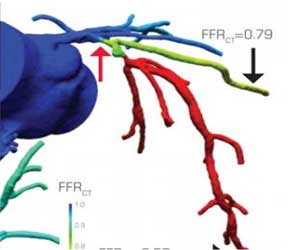- Home
- Editorial
- News
- Practice Guidelines
- Anesthesiology Guidelines
- Cancer Guidelines
- Cardiac Sciences Guidelines
- Critical Care Guidelines
- Dentistry Guidelines
- Dermatology Guidelines
- Diabetes and Endo Guidelines
- Diagnostics Guidelines
- ENT Guidelines
- Featured Practice Guidelines
- Gastroenterology Guidelines
- Geriatrics Guidelines
- Medicine Guidelines
- Nephrology Guidelines
- Neurosciences Guidelines
- Obs and Gynae Guidelines
- Ophthalmology Guidelines
- Orthopaedics Guidelines
- Paediatrics Guidelines
- Psychiatry Guidelines
- Pulmonology Guidelines
- Radiology Guidelines
- Surgery Guidelines
- Urology Guidelines
FFR-CT superior to conventional CT angiogram for predicting heart disease

The CT-derived fractional flow reserve, FFRCT is superior to conventional coronary CT angiogram in predicting long-term cardiovascular outcomes such as cardiac death, myocardial infarction, unplanned revascularization, reported a study published in the journal Radiology.
The study was conducted to ascertain the long term prognostic value of CT-derived FFRCT as it has shown better results in detecting lesion-specific ischemia.
The prospective subanalysis of the NXT study evaluated participants suspected of having stable coronary artery disease who were referred for invasive angiography and who underwent FFR, coronary CT angiography, and FFRCT. The incidence of the composite primary endpoint of death, myocardial infarction, and any revascularization and the composite secondary endpoint of major adverse cardiac events (MACE: cardiac death, myocardial infarction, unplanned revascularization) were compared for an FFRCT of 0.8 or less versus stenosis of 50% or greater on coronary CT angiograms, with treating physicians blinded to the FFRCT result.
Long-term outcomes were obtained in 206 individuals, including 64% men. At an average follow-up of 4.7 years, there were no cardiac deaths or myocardial infarctions in participants with normal FFRCT. The incidence of the primary endpoint was more frequent in participants with positive FFRCTcompared with clinically significant stenosis at coronary CT angiography, with the majority of outcomes being planned revascularization.
The authors noted that FFRCT was a superior predictor compared with coronary CT angiography for primary endpoint and MACE. Frequency of MACE was higher in participants with positive FFRCT compared with coronary CT angiography, driven by unplanned revascularization.
The authors concluded that in stable patients referred for invasive angiography, a CT-derived fractional flow reserve (FFRCT) value of 0.8 or less was a predictor of long-term outcomes driven by planned and unplanned revascularization and was superior to clinically significant stenosis on coronary CT angiograms. Additionally, the numeric value of FFRCTwas an independent predictor of outcomes.
For further reference, click on the link

Disclaimer: This site is primarily intended for healthcare professionals. Any content/information on this website does not replace the advice of medical and/or health professionals and should not be construed as medical/diagnostic advice/endorsement or prescription. Use of this site is subject to our terms of use, privacy policy, advertisement policy. © 2020 Minerva Medical Treatment Pvt Ltd